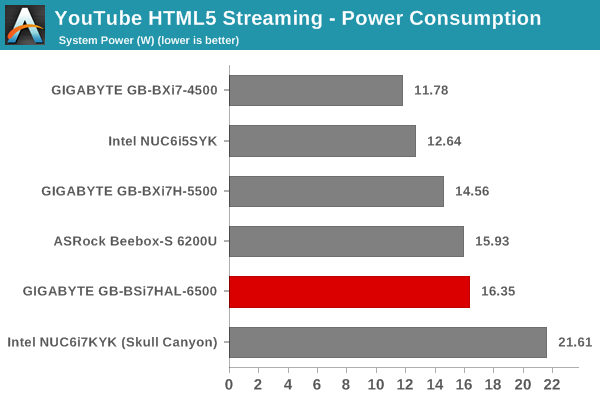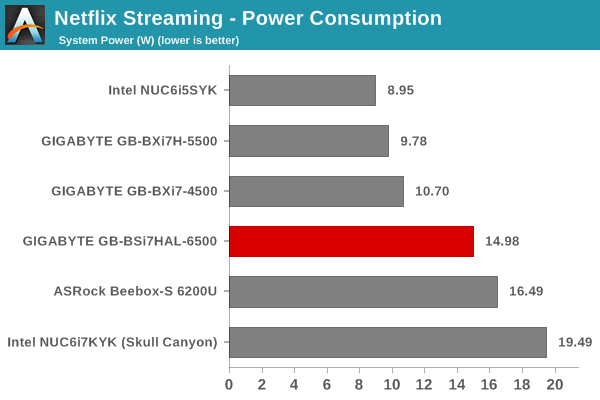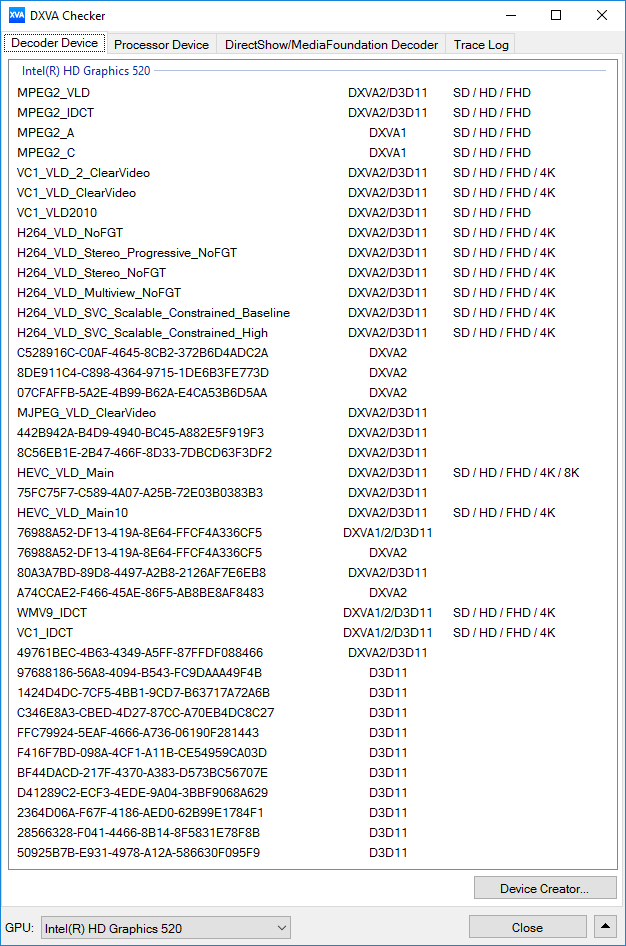GIGABYTE GB-BSi7HAL-6500 Dual LAN Skylake BRIX Review
by Ganesh T S on September 21, 2016 8:00 AM ESTHTPC Credentials
The GB-BSi7HAL-6500 is an actively cooled PC, and its two LAN ports make it suitable for use in networking applications. The fan curves in the BIOS are also quite aggressive, making it a bit more noisy compared to other Skylake-U PCs that we have evaluated before. As such, we don't think it is a suitable candiate for a HTPC. However, there are other Skylake BRIX models based on the Core i7-6500U that are more HTPC-friendly, and it is worth looking at the HTPC aspects of the platform.
Refresh Rate Accurancy
Starting with Haswell, Intel, AMD and NVIDIA have been on par with respect to display refresh rate accuracy. The most important refresh rate for videophiles is obviously 23.976 Hz (the 23 Hz setting). As expected, the GIGABYTE GB-BSi7HAL-6500 has no trouble with refreshing the display appropriately in this setting.
The gallery below presents some of the other refresh rates that we tested out. The first statistic in madVR's OSD indicates the display refresh rate.
Network Streaming Efficiency
Evaluation of OTT playback efficiency was done by playing back our standard YouTube test stream and five minutes from our standard Netflix test title. Using HTML5, the YouTube stream plays back a 720p encoding. Since YouTube now defaults to HTML5 for video playback, we have stopped evaluating Adobe Flash acceleration. Note that only NVIDIA exposes GPU and VPU loads separately. Both Intel and AMD bundle the decoder load along with the GPU load. The following two graphs show the power consumption at the wall for playback of the HTML5 stream in Mozilla Firefox (v 47.0.1).

GPU load and VPU load were around 19.49% and 0.174% for the YouTube HTML5 stream. GPU load in the steady state for the Netflix streaming case was 0.0163% and the VPU load was 0.0471%.
Netflix streaming evaluation was done using the Windows 10 Netflix app. Manual stream selection is available (Ctrl-Alt-Shift-S) and debug information / statistics can also be viewed (Ctrl-Alt-Shift-D). Statistics collected for the YouTube streaming experiment were also collected here. It can be seen that the GB-BSi7HAL-6500 is not a particularly power efficient platform for OTT streaming.

Decoding and Rendering Benchmarks
In order to evaluate local file playback, we concentrate only on Kodi 16.1 with default settings. We already know that EVR works quite well even with the Intel IGP for our test streams. In our earlier reviews, we focused on presenting the GPU loading and power consumption at the wall in a table (with problematic streams in bold). Starting with the Broadwell NUC review, we decided to represent the GPU load and power consumption in a graph with dual Y-axes. Nine different test streams of 90 seconds each were played back with a gap of 30 seconds between each of them. The characteristics of each stream are annotated at the bottom of the graph. Note that the GPU usage is graphed in red and needs to be considered against the left axis, while the at-wall power consumption is graphed in green and needs to be considered against the right axis.
Frame drops are evident whenever the GPU load consistently stays above the 85 - 90% mark. However, the GB-BSi7HAL-6500 has no trouble with our video benchmarking suite (as has become customary with all the mini-PCs that we have evaluated this year). Our suite is yet to integrate HEVC clips, but, we can get an idea of the decoding capabilities of the GB-BSi7HAL-6500 with the help of DXVA Checker.
Intel has already disclosed that the HEVC_VLD_Main10 10b decoding support in Skylake is hybrid in nature. If decoding such streams is a primary use-case, then, it is suggested that a more powerful PC be utilized. However, for most common 1080p use-cases, the GB-BSi7HAL-6500 is more than sufficient. Though the SKU that we are reviewing doesn't have HDMI 2.0, certain other BRIX models with Core i7-6500U are a bit future-proof with the 4Kp60 HDMI 2.0 output.


















25 Comments
View All Comments
cknobman - Wednesday, September 21, 2016 - link
The price on these platforms is downright ridiculous.I know small has its price but at this point it just seems like Intel is profiteering.
powerarmour - Wednesday, September 21, 2016 - link
That price is an utter joke.ddriver - Wednesday, September 21, 2016 - link
More like mockery.nagi603 - Thursday, September 22, 2016 - link
Yeah, for the same price, (well, actually quite less, but with "only" 16GB ram and a 256GB SSD) I put together a mini-ITX box with a proper desktop-class i7.... And thanks to the bigger size, it is quite silent.JoeyJoJo123 - Wednesday, September 21, 2016 - link
You know, I actually got rather excited when I saw it'd be a dual LAN mini PC on Skylake, as this would work out very well for a pfSense router-box.>$591.
>$1030 as configured.
No thanks... Might be better to stick with one of those cheap chinese dual lan mini-PCs instead...
barleyguy - Thursday, September 22, 2016 - link
The Zotac ZBox EN760 has GTX 960 graphics as well as the dual lan ports, and could easily be configured comparably to this. That probably falls in your "cheap Chinese mini PCs" category, though I think Zotac is Tawainese.It's possibly on a lower quality tier than the Intel NUC or Gigabyte Brix. That said, I have the older version of it (EN860) and it works great as an HTPC box.
I have actually considered the Intel NUC for use with Thunderbolt pro audio. If you're pairing it up with thousands of dollars of studio gear the price seems less egregious. But if the Thunderbolt port is going to go unused, there's really no reason to choose that direction.
JoeyJoJo123 - Thursday, September 22, 2016 - link
The discrete graphics adds additional heat and cost that isn't useful for a pfSense box. It essentially acts as a server/router, using one LAN port as a WAN directly from a modem, then routes packets out accordingly from the other LAN port(s).Many Chinese fanless versions exist, but they use anemic celerons and atom CPUs. When you start using many extra features of pfSense, like squid (as a webproxy) the router's maximum throughput drops. Now this isn't an issue unless you have some kind of insane symmetrical 1gpbs up/down connection, where processor would fail to saturate the entire pipe.
I'd prefer to not have to worry, so I'd be all in for a fanless Mini-STX case and socketing in my own 6300T or something, but there are no fanless Mini-STX cases, and no Mini-STX motherboards with dual LAN. There are fanless thin Mini-ITX cases from Akasa, but I wasn't able to source a cheapish i3 + thin Mini-ITX mobo with dual LAN.
fanofanand - Wednesday, September 21, 2016 - link
$1030 using an iGPU. Pass.fanofanand - Wednesday, September 21, 2016 - link
Had to post a second comment, comparing this to the Skull Canyon, which has a better GPU/CPU, better wi-fi, and a better SSD really hurts the Brix. $3 less for nearly every component being better except 16 GB of RAM vs 32 GB. What use case does this box have where 32 GB of RAM becomes a factor? Are people running dozens of VMs off a box like this? I don't know about profiteering, but I don't see them selling many of these.kmmatney - Wednesday, September 21, 2016 - link
I can't see running too many VMs. The i7-6500U performs worse than an i3-6100 (uses a lot less power, but still...). I know going into these reviews that the prices will shock me, yet I'm still shocked when I see them.